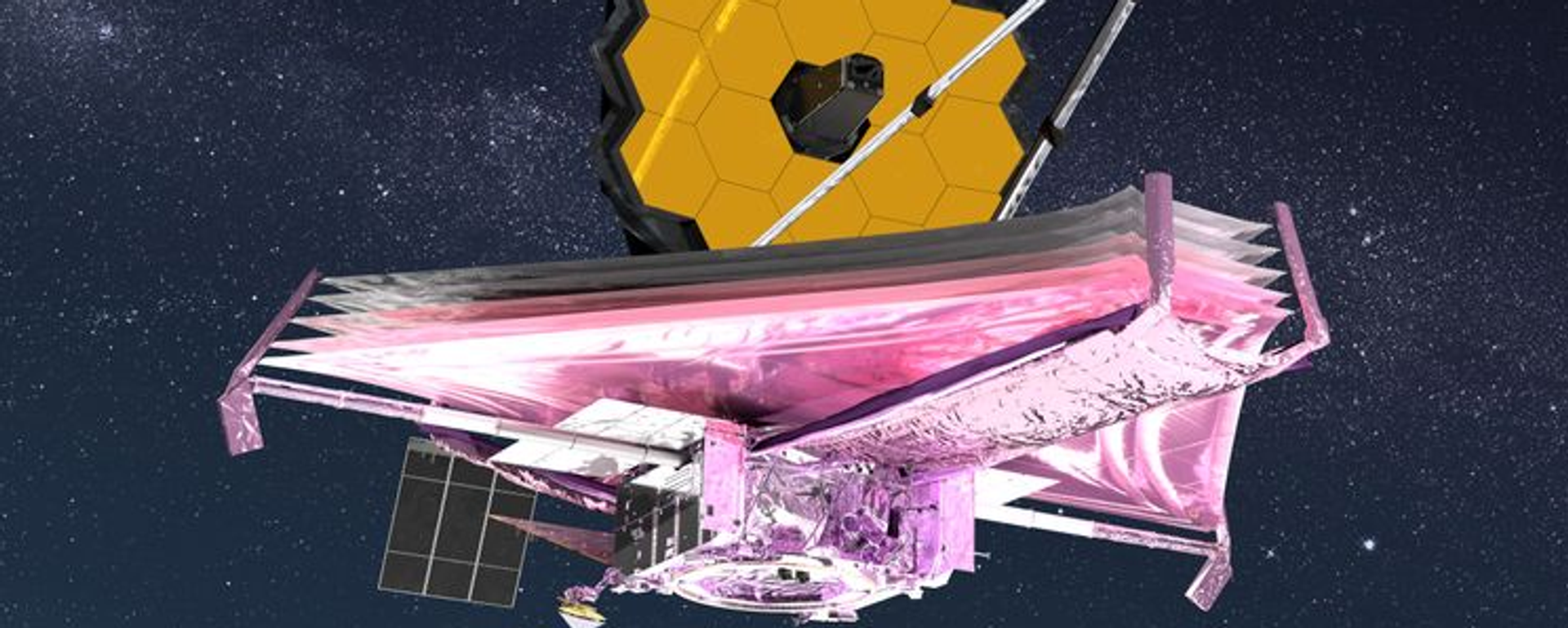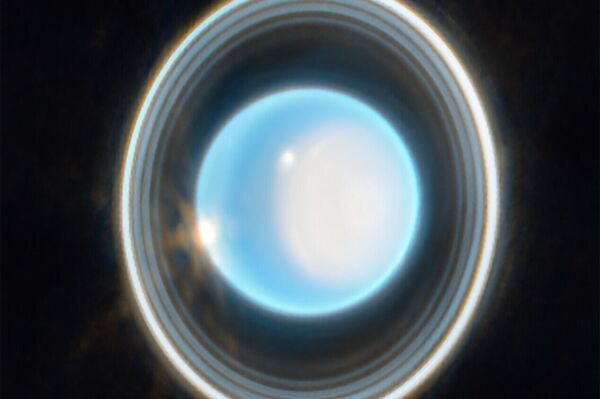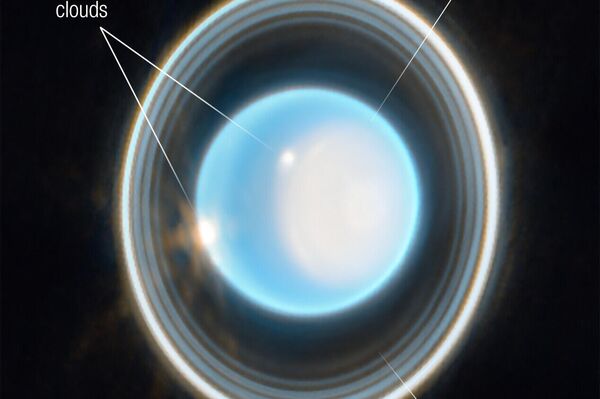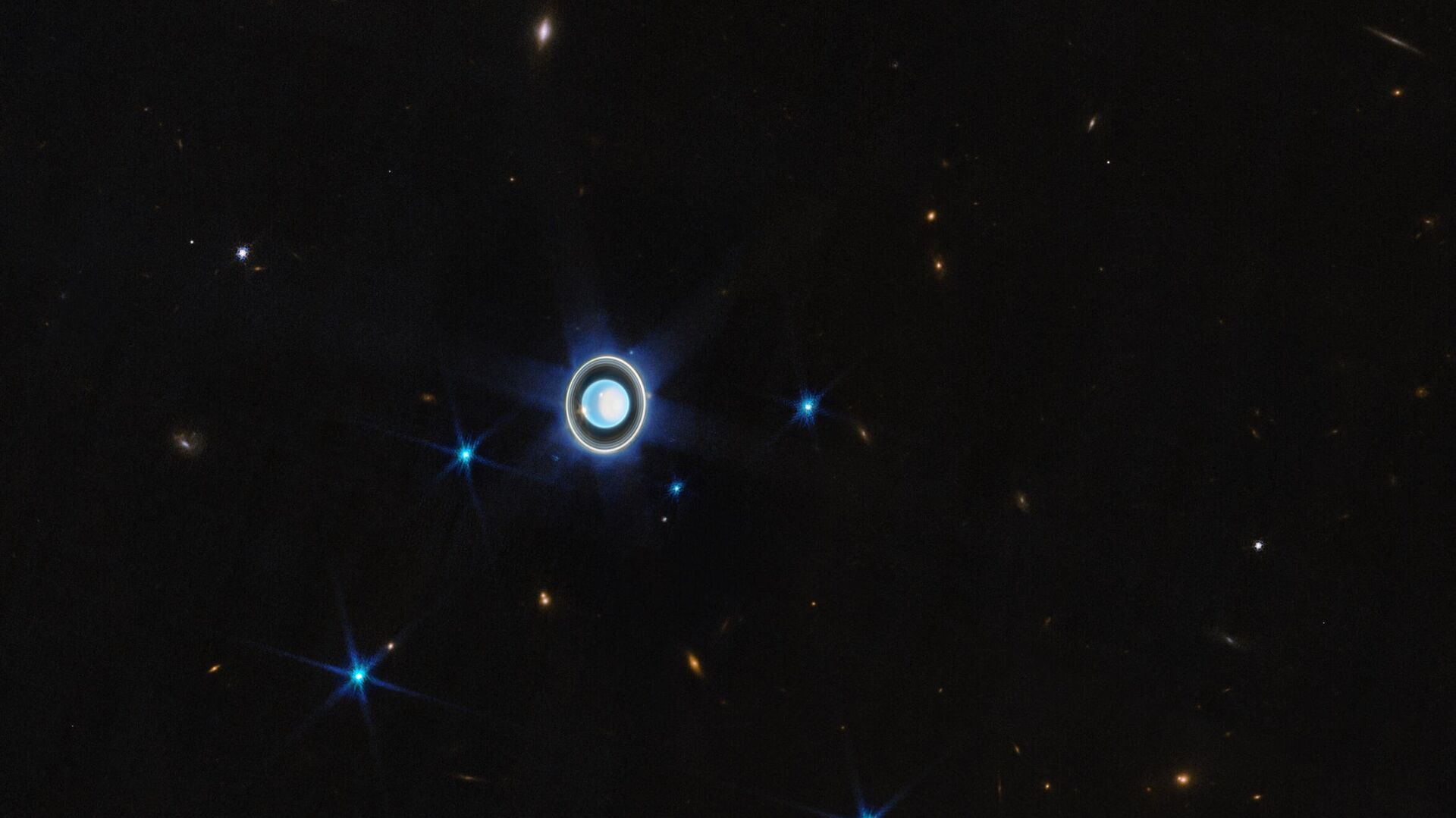https://sputnikglobe.com/20230411/webb-telescope-reveals-hidden-rings-around-uranus--1109348540.html
Webb Telescope Reveals 'Hidden' Rings Around Uranus
Webb Telescope Reveals 'Hidden' Rings Around Uranus
Sputnik International
The James Webb Space Telescope, the most powerful space telescope, sees the Universe in infrared and near-infrared, making it perfect for capturing the stretched glow of light that was shed billions of years in our past.
2023-04-11T14:45+0000
2023-04-11T14:45+0000
2023-06-20T17:11+0000
science & tech
astronomy
uranus
solar system
space
space exploration
https://cdn1.img.sputnikglobe.com/img/07e7/04/0b/1109347724_0:191:2350:1512_1920x0_80_0_0_10f4aa05172f484a766012e74ffe51d7.jpg
The James Webb Space Telescope has captured stunning new images of Uranus, the seventh planet from the Sun. Uranus is known for its peculiar characteristics, including an unusual rotation and an icy, gelid appearance. However, when viewed with thermal imaging, scientists can detect the physical properties of Uranus' faint, icy rings, which were captured by the telescope.The telescope's infrared and near-infrared sensitivity enables it to reveal a lot about the workings of Uranus. In a brief 12-minute observation, the JWST was able to resolve never-before-seen details of Uranus, including a polar brightening as the planet moves into the full light of the summer Sun. This feature is unique to Uranus, and its cause is still unknown, but scientists hope to use the data captured by JWST to study it in detail.The image also revealed the planet's clouds, which are linked to storm activity in the predominantly hydrogen and helium atmosphere of the ice giant. Uranus has just over a dozen humble circlets, and JWST imaged 11 of the 13 known rings circling the planet, including the two faint, dusty inner rings that were only discovered when Voyager 2 flew by in 1986. JWST observations in the future will be aimed at capturing the two faint outer rings beyond the main group.In addition to the rings, the JWST captured six, of Uranus' 27 known moons, some of which have very different orbits. Uranus has a collection of irregular, much more distant moons that have inclined, elliptical orbits, similar to those of Jupiter's irregular moons.With future James Webb observations of Uranus ongoing, scientists hope to learn more about this intriguing planet and make a compelling case for sending a probe to study it in detail.
https://sputnikglobe.com/20230108/james-webb-telescope-exposes-dawn-of-universe-galactic-features-1106141388.html
Sputnik International
feedback@sputniknews.com
+74956456601
MIA „Rossiya Segodnya“
2023
Sputnik International
feedback@sputniknews.com
+74956456601
MIA „Rossiya Segodnya“
News
en_EN
Sputnik International
feedback@sputniknews.com
+74956456601
MIA „Rossiya Segodnya“
Sputnik International
feedback@sputniknews.com
+74956456601
MIA „Rossiya Segodnya“
space, uranian system, uranus telescope image. space research
space, uranian system, uranus telescope image. space research
Webb Telescope Reveals 'Hidden' Rings Around Uranus
14:45 GMT 11.04.2023 (Updated: 17:11 GMT 20.06.2023) The James Webb Space Telescope (JWST), the most powerful space telescope ever launched, sees the Universe exclusively in infrared and near-infrared, making it perfect for capturing the stretched glow of light that was shed billions of years in our past.
The James Webb Space Telescope has captured stunning new images of Uranus, the seventh planet from the Sun. Uranus is known for its peculiar characteristics, including an unusual rotation and an icy, gelid appearance. However, when viewed with thermal imaging, scientists can detect the physical properties of Uranus' faint, icy rings, which were captured by the telescope.
Zoomed-in image of Uranus
Zoomed-in image of Uranus
The telescope's infrared and near-infrared sensitivity enables it to reveal a lot about the workings of Uranus. In a brief 12-minute observation, the JWST was able to resolve never-before-seen details of Uranus, including a polar brightening as the planet moves into the full light of the summer Sun. This feature is unique to Uranus, and its cause is still unknown, but scientists hope to use the data captured by JWST to study it in detail.
The image also revealed the planet's clouds, which are linked to storm activity in the predominantly hydrogen and helium atmosphere of the ice giant. Uranus has just over a dozen humble circlets, and JWST imaged 11 of the 13 known rings circling the planet, including the two faint, dusty inner rings that were only discovered when Voyager 2 flew by in 1986. JWST observations in the future will be aimed at capturing the two faint outer rings beyond the main group.

8 January 2023, 17:05 GMT
In addition to the rings, the JWST captured six, of Uranus' 27 known moons, some of which have very different orbits. Uranus has a collection of irregular, much more distant moons that have inclined, elliptical orbits, similar to those of Jupiter's irregular moons.
With future James Webb observations of Uranus ongoing, scientists hope to learn more about this intriguing planet and make a compelling case for sending a probe to study it in detail.




